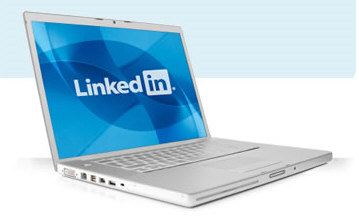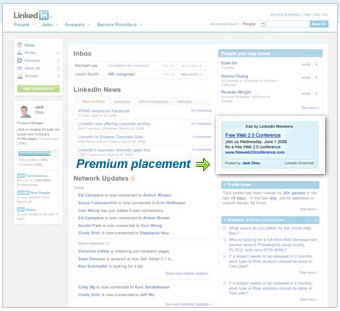 The new LinkedIn DirectAds service allows you to address in a very targeted way, professionals and other work contacts with highly targeted ads that you create yourself.
The LinkedIn professional network community is made up of senior executives, salespeople, and industry experts in just about any market industry, counting over 20 million professionals with an average household income: $109,000.
The cost is relatively lowas you can get started with as little as $25 and move up from there.
Business content analyst John Blossom, provides an excellent intro and overview of this new direct advertising approach utilized by LinkedIn while dissecting its key strengths and future opportunities.
He writes:
The new LinkedIn DirectAds service allows you to address in a very targeted way, professionals and other work contacts with highly targeted ads that you create yourself.
The LinkedIn professional network community is made up of senior executives, salespeople, and industry experts in just about any market industry, counting over 20 million professionals with an average household income: $109,000.
The cost is relatively lowas you can get started with as little as $25 and move up from there.
Business content analyst John Blossom, provides an excellent intro and overview of this new direct advertising approach utilized by LinkedIn while dissecting its key strengths and future opportunities.
He writes: "Executives are a conservative bunch when it comes to dealing with their personal reputations, but LinkedIn has proved to more than 20 million professionals so far that it is by and large a very trustworthy environment. With that trust as a primary asset, it's likely that LinkedIn has set the stage for some solid revenue development that is likely to upend a few B2B applecarts in the long run. For the time being, though LinkedIn is just at the begininning of what promises to be a long battle for the rights to what professionals value most in carrying out their business - trusted relationships that can yield revenues."Here the full story:
The Payoff: LinkedIn Focuses on Monetization through Ads and Targeted Research
 by John Blossom
LinkedIn's growing success is both admired and feared by many in the content business, but the rap against them for quite some time has been, "Well, yeah, but where's the monetization?"
In truth, LinkedIn has been growing revenues steadily through traditional brand ads, partnerships and payments for premium services.
But with two key moves LinkedIn is raising the bar on its prospects for revenues - and for a potential exit at a more appreciable price.
by John Blossom
LinkedIn's growing success is both admired and feared by many in the content business, but the rap against them for quite some time has been, "Well, yeah, but where's the monetization?"
In truth, LinkedIn has been growing revenues steadily through traditional brand ads, partnerships and payments for premium services.
But with two key moves LinkedIn is raising the bar on its prospects for revenues - and for a potential exit at a more appreciable price.
DirectAds
 The fist LinkedIn initative is its new DirectAds service, which enables LinkedIn members with profiles to produce simple text ads on a self-service basis that can appear in other members' profile pages.
Similar in overall concept to Facebook's SocialAds program - a link to the advertiser's profile appears in each ad to ensure that marketing is on a conversational basis with a known entitiy - DirectAds has the added benefit of being able to target executive peers in the LinkedIn network with a great deal of granularity - and charges healthy but affordable minimum rates to do so - a $25 minimum for a flight of ads, with impressions based on a variable formula.
Filtering options include many of the criteria found in a typical member's profile, including the ability to limit ads to specific geographic regions.
The fist LinkedIn initative is its new DirectAds service, which enables LinkedIn members with profiles to produce simple text ads on a self-service basis that can appear in other members' profile pages.
Similar in overall concept to Facebook's SocialAds program - a link to the advertiser's profile appears in each ad to ensure that marketing is on a conversational basis with a known entitiy - DirectAds has the added benefit of being able to target executive peers in the LinkedIn network with a great deal of granularity - and charges healthy but affordable minimum rates to do so - a $25 minimum for a flight of ads, with impressions based on a variable formula.
Filtering options include many of the criteria found in a typical member's profile, including the ability to limit ads to specific geographic regions.
DirectAds Potential
 The potential for DirectAds is very strong within LinkedIn itself, but it also has the potential to provide B2B publishers with some real concerns as this evolves. Though there is no announced plan to take DirectAds off-site into other publishing venues, certainly classifieds in B2B journals and Web sites could be easily targeted by LinkedIn with its extensive network of top-shelf executives and salespeople.
More importantly, it's not too hard to imagine that a B2B publisher seeking revenues from companies trying to get a message through to very specific executives would jump at the chance to use DirectAds to get rates far higher than classifieds for its very targeted profiling capabilities.
In very tightly knit B2B communities DirectAds would play very well in B2B publishing venues.
Technologically, it would not be hard to implement at all - it would only take enabling a B2B publishing site with Google's OpenSocial API.
With such a combination DirectAds would have a Google AdWords/AdSense revenue combo for on-site/off-site revenues that could be impressive indeed.
If done properly - hopefully avoiding Facebook's pratfall with its Beacon program that released private data in a user-unfriendly manner - this has the potential to be to B2B publishing what Google was to consumer publishing, turning advertising into relationship building with one click of the mouse.
With its potential for ultra-precise targeting, it could put somewhat of a dent in marketing lists services as well in time.
The potential for DirectAds is very strong within LinkedIn itself, but it also has the potential to provide B2B publishers with some real concerns as this evolves. Though there is no announced plan to take DirectAds off-site into other publishing venues, certainly classifieds in B2B journals and Web sites could be easily targeted by LinkedIn with its extensive network of top-shelf executives and salespeople.
More importantly, it's not too hard to imagine that a B2B publisher seeking revenues from companies trying to get a message through to very specific executives would jump at the chance to use DirectAds to get rates far higher than classifieds for its very targeted profiling capabilities.
In very tightly knit B2B communities DirectAds would play very well in B2B publishing venues.
Technologically, it would not be hard to implement at all - it would only take enabling a B2B publishing site with Google's OpenSocial API.
With such a combination DirectAds would have a Google AdWords/AdSense revenue combo for on-site/off-site revenues that could be impressive indeed.
If done properly - hopefully avoiding Facebook's pratfall with its Beacon program that released private data in a user-unfriendly manner - this has the potential to be to B2B publishing what Google was to consumer publishing, turning advertising into relationship building with one click of the mouse.
With its potential for ultra-precise targeting, it could put somewhat of a dent in marketing lists services as well in time.
The LinkedIn Research Network
 The other interesting new program at LinkedIn is the LinkedIn Research Network, which leverages some of the concepts that it employed in LinkedIn Answers to provide a tool that can enable executives to conduct peer-to-peer industry research.
The other interesting new program at LinkedIn is the LinkedIn Research Network, which leverages some of the concepts that it employed in LinkedIn Answers to provide a tool that can enable executives to conduct peer-to-peer industry research.
 As in LinkedIn Answers members of LinkedIn can pose questions to peers in the LinkedIn network, using LinkedIn's extensive structured and unstructured member profile data to zero in on just the right people to target for questions.
The Research Network provides its users with a workbench to monitor responses to questions and to in effect build research panel who can be contacted for additional questions.
The revenue hook in Linked in Research Network is its use of LinkedIn's private InMail network to contact members. Members may use InMail for contacting up to 20 people at a time, presumably to cut down on "spam" research requests and presumably to make it easier to meter the pricing to a reasonable block of minimum requests.
Of course, one can sign up for InMail at any number of premium levels, so the real hook is to promote InMail premium subscription revenues as much as possible. Given that the demo video was intent on saying that this product was targeted primarily at financial industry analysts trying to contact experts in companies and market sectors, perhaps their initial expectations for its use are limited. But clearly its ability to combine the art of research into the art of marketing will make this a popular option for many over time.
As in LinkedIn Answers members of LinkedIn can pose questions to peers in the LinkedIn network, using LinkedIn's extensive structured and unstructured member profile data to zero in on just the right people to target for questions.
The Research Network provides its users with a workbench to monitor responses to questions and to in effect build research panel who can be contacted for additional questions.
The revenue hook in Linked in Research Network is its use of LinkedIn's private InMail network to contact members. Members may use InMail for contacting up to 20 people at a time, presumably to cut down on "spam" research requests and presumably to make it easier to meter the pricing to a reasonable block of minimum requests.
Of course, one can sign up for InMail at any number of premium levels, so the real hook is to promote InMail premium subscription revenues as much as possible. Given that the demo video was intent on saying that this product was targeted primarily at financial industry analysts trying to contact experts in companies and market sectors, perhaps their initial expectations for its use are limited. But clearly its ability to combine the art of research into the art of marketing will make this a popular option for many over time.
Future Outlook
 With both of these options LinkedIn is taking a relatively low-key approach to product development, moving relatively slowly to ensure that their most valuable asset - the trust and security that the LinkedIn system of opt-in relationships has protected through its development - will not be tainted or abused.
Executives are a conservative bunch when it comes to dealing with their personal reputations, but LinkedIn has proved to more than 20 million professionals so far that it is by and large a very trustworthy environment.
With that trust as a primary asset, it's likely that LinkedIn has set the stage for some solid revenue development that is likely to upend a few B2B applecarts in the long run.
For the time being, though LinkedIn is just at the beginning of what promises to be a long battle for the rights to what professionals value most in carrying out their business - trusted relationships that can yield revenues.
N.B.: DirectAds is currently available to only a limited set of LinkedIn members, but we plan on opening up to more advertisers soon.
With both of these options LinkedIn is taking a relatively low-key approach to product development, moving relatively slowly to ensure that their most valuable asset - the trust and security that the LinkedIn system of opt-in relationships has protected through its development - will not be tainted or abused.
Executives are a conservative bunch when it comes to dealing with their personal reputations, but LinkedIn has proved to more than 20 million professionals so far that it is by and large a very trustworthy environment.
With that trust as a primary asset, it's likely that LinkedIn has set the stage for some solid revenue development that is likely to upend a few B2B applecarts in the long run.
For the time being, though LinkedIn is just at the beginning of what promises to be a long battle for the rights to what professionals value most in carrying out their business - trusted relationships that can yield revenues.
N.B.: DirectAds is currently available to only a limited set of LinkedIn members, but we plan on opening up to more advertisers soon.
 Originally written by John Blossom for Shore and first published on June 30 2008 as "The Payoff: LinkedIn Focuses on Monetization through Ads and Targeted Research"
Originally written by John Blossom for Shore and first published on June 30 2008 as "The Payoff: LinkedIn Focuses on Monetization through Ads and Targeted Research"

